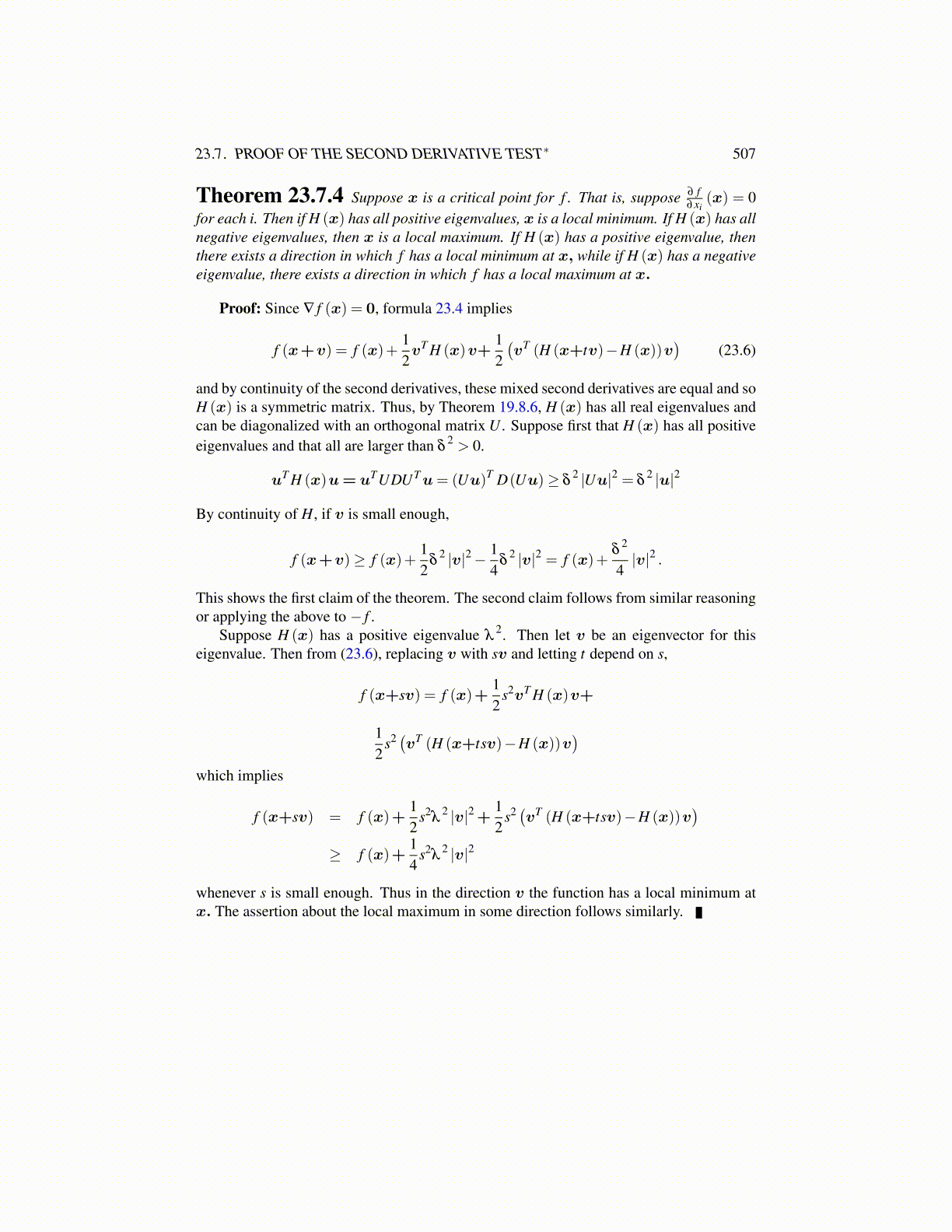
Chapter 24
Implicit Function Theorem*This chapter can be skipped and returned to later if desired. It contains the theoreticalbackground for the method of Lagrange multipliers and other items.
First is the version involving the case where f is a function of two scalar variables andhas values in R. The partial derivatives D1 f ,D2 f are just derivatives obtained from fixingy in the first case and x in the second. Thus D1 f (x,y) ≡ limh→0
f (x+h,y)− f (x,y)h , similar for
D2 f (x,y) . Continuity means that if xn → x, and yn → y, then f (xn,yn)→ f (x,y).
Theorem 24.0.1 Let (x0,y0) ∈ I × J where I,J are open intervals and supposef (x0,y0) = 0 where D1 f ,D2 f , f are continuous on I × J. Also suppose D1 f (x0,y0) ̸= 0.Then there exist open intervals Î ⊆ I, Ĵ ⊆ J with (x0,y0) ∈ Î × Ĵ and a unique functionx : Ĵ → Î which has continuous derivative such that f (x(y) ,y) = 0 for all y ∈ Ĵ.
Proof: There exist Ĩ, J̃ closed intervals contained in I,J respectively such that x0 isin the interior of Ĩ,y0 is in the interior of J̃ and D1 f (x,y) nonzero on Ĩ × J̃. This is bycontinuity of the partial derivative. Then fixing y ∈ J̃, if f (x1,y) = f (x2,y) = 0, you wouldhave, by the mean value theorem, D1 (z,y)(x1 − x2) = 0 for some z between x1 and x2.Hence D1 f (z,y) = 0 which does not happen. Hence there is at most one x for whichf (x,y) = 0 for each y ∈ J̃.
claim: There exists open Ĵ ⊆ J̃ such that Ĵ contains y0 and for y ∈ Ĵ, the minimum ofx → f 2 (x,y) on Ĩ × Ĵ occurs at an interior point of Ĩ.
Proof of claim: If not, there exists yn → y0 and xn an endpoint of Ĩ such that the min-imum of x → f 2 (x,y) occurs at xn. One of these endpoints occurs infinitely often andso there is a subsequence, still called xn which converges to an endpoint w of Ĩ. Thenf 2 (x0,yn) ≥ f 2 (xn,yn) and so, by continuity, f 2 (x0,y0) ≥ f 2 (w,y0) and so, there are twodifferent points of Ĩ namely x0,w with f (x0,y0) = f (w,y0) = 0. This was just shown im-possible. This proves the claim.
Let Ĵ be as just described and let x(y) be the point of Ĩ for which f (x(y) ,y) minimizesx → f 2 (x,y). Then fixing y,2 f (x(y) ,y)D1 f (x(y) ,y) = 0 and so, f (x(y) ,y) = 0. It re-mains to verify that y → x(y) is differentiable. If y ∈ Ĵ, then if |h| is small enough, bothy,y+h are in Ĵ. Considering such small h,
0 = f (x(y+h) ,y+h)− f (x(y) ,y)
= f (x(y+h) ,y+h)− f (x(y) ,y+h)+ f (x(y) ,y+h)− f (x(y) ,y)
= D1 f (z(h) ,y+h)(x(y+h)− x(y))+D2 f (x(y) ,y+wh)h
where wh is between 0 and h and z(h) is between x(y) and x(y+h) . This is by the meanvalue theorem. Thus, the term on the right converges to 0 as h → 0 and so it is also truethat x(y+h)− x(y) → 0 so y → x(y) is continuous. Then z(h) → x(y) also and so, bycontinuity you can take the limit as h → 0 in
x(y+h)− x(y)h
=−D2 f (x(y) ,y+wh)
D1 f (z(h) ,y+h)
and obtain x′ (y) exists and equals −D2 f (x(y),y)D1 f (x(y),y) which shows also that y → x′ (y) is continu-
ous by continuity of D2 and D1. Now let Î ≡ x(Ĵ). This smaller interval contains x0 since
x(y0) = x0 and is an open interval because y → x(y) is one to one and continuous.
507